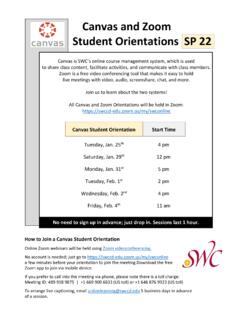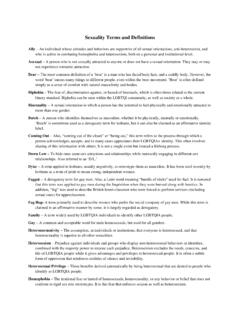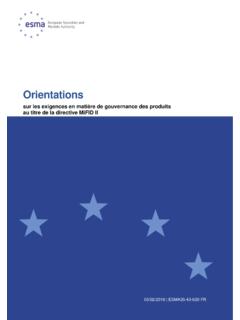Transcription of Curriculum Orientations and Educational Philosophies of ...
1 International Education Studies; Vol. 11, No. 4; 2018 ISSN 1913-9020 E-ISSN 1913-9039 Published by Canadian Center of Science and Education 92 Curriculum Orientations and Educational Philosophies of High School Arabic Teachers Abeer Saleh Alsalem1 1 College of Social Sciences, Imam Muhammad ibn Saud Islamic University, Kingdom of Saudi Arabia Correspondence: Abeer Saleh Alsalem, College of Social Sciences, Imam Muhammad ibn Saud Islamic University, Kingdom of Saudi Arabia. E-mail: Received: November 27, 2017 Accepted: January 5, 2018 Online Published: March 28, 2018 URL: Abstract This study aims to investigate the Curriculum Orientations of High school Arabic teacher in Riyadh city and to examine the relationship between Curriculum orientation and their Educational Philosophies .
2 The quantitative method (descriptive study) was adopted in this questionnaire survey-based study. Mean and standard deviation for the overall of the Curriculum Orientations and for each orientation were obtained and Pearson correlation coefficient was also used to examine the relationship between the Curriculum Orientations and their Educational Philosophies . The results show that Arabic teachers of High school considered all five Curriculum Orientations with the self-actualization/ Humanism ranked the highest orientation and the cognitive process ranked the lowest orientation . The current study also indicates that there is a positive relationship at the level of ( ) between the Curriculum Orientations and the Educational Philosophies of the Arabic language teachers in High school.
3 Keywords: Curriculum orientation , Educational philosophy, Arabic teaches of high school 1. Introduction Curriculum orientation is defined as teachers belief about the education goal and the Curriculum components such as objectives, content, teaching, learning, activities, and assessment methods (Cheung & Ng, 2000). Eisner and Vallance (1947) propose five Curriculum Orientations : academic rationalism, cognitive process, social reconstruction, self-actualization and technology. Each orientation has specific beliefs about Curriculum design and Curriculum elements (Cheung & Wong, 2002). Academic rationalism stresses that intellectual process and content help students act like historian or scientific.
4 The role of teacher is to assist students in mastering of the concepts, content and the main ideas of the academic discipline (Tanriverdi & Apak, 2014). Unlike the academic rationalism, cognitive process orientation focuses on learning process than content; therefore, the role of teacher is to facilitate the learning process and create environment that help students practice solve-problem skills, ask questions and think critically. The third orientation is Self-Actualization (Humanistic) stresses the students needs and interests, so the role of teacher is to provide students with opportunities and experiences that allow them to grow and to serve their personal development (Tanriverdi & Apak, 2014). Otherwise, the Curriculum of social reconstruction orientation centers to communities problems.
5 Therefore, the aim of Curriculum is to help students think about their communities issues and try to solve them and make decisions, and the role of teacher is to create safe and open environment that encourage students to ask questions and think critically and reflectively. Technology orientation is the fifth Curriculum orientation which focuses on planning the Curriculum systematically so the role of teacher is to set the learning objective and achieve them (Eisner & Vallance, 1947). Teachers adopt the Curriculum Orientations based on their Educational philosophy (s) and their Orientations of Curriculum are influenced by their Philosophies (Tanriverdi & Apak, 2014). In the literature of education, there are four main Educational philosophes which related to the Curriculum orientation .
6 The first philosophy is Perennialism that emphasizes subject matter, content, and knowledge, including the so-called humanities, the common culture of Western civilization (grammar, reading, rhetoric, logic, mathematics, and great literature). Hutchins called these the permanent studies (Hlebowitsh, 2005, p. 59). Proponents of perennialism care about keeping and passing on their culture from one generation to the next. Therefore, the role of the student is to receive knowledge from the teacher and the role of the teacher is to teach the student basic knowledge and the skills necessary to gaining an understanding of the content. These skills will enable students eventually think of their International Education Studies Vol.
7 11, No. 4; 2018 93 way through the subject matter (Hlebowitsh, 2005, p. 60). The second philosophy is Progressivism which is embodied in Dewey s theory which places more emphasis on the learners than on subject matter. Progressivist philosophy cares about the reconstruction of experience, meaning that it is helpful for learners to learn from their experience to avoid repeating their mistakes. Therefore, they will be able to make wiser decisions in the future. In addition, such reconstruction will allow learners to create new knowledge based on their prior knowledge and experiences (Null, 2011). A progressivist environment encourages students to ask good questions, especially those starting with why. This will assist them in developing the ability to think more critically, solve problems, and to enjoy collaboration and engagement with others.
8 The third philosophy is social efficiency that focuses on society needs and it emphasizes on designing the Educational objectives. The proponents of this ideology such as Bobbitt, 1913 and Tyler 1949 believed that the Educational objectives help Curriculum makers design the other components of Curriculum such as the learner experience, content, activities, and the methods of assessment. With social efficiency philosophy, the learner work in school that provides their energy for Educational product, and the role of the teacher is to manage the conditions of the learning (Schiro, 2013). The fourth philosophy is Social Reconstructionism that places emphasis on addressing social questions to create a better society.
9 In addition, it should be devoted to the promotion of social welfare through education (Counts, 1978, p. 5). It believes that ethics and intellect cannot be separated (Null, 2011, ).The role of the school is to prepare people to create a new social order. In addition, educators should focus on a Curriculum that highlights social reform as the aim of education, and focuses on student experience and on taking social action to resolve real problems such as hunger, international terrorism, inflation, and inequality. Teachers should create an environment that helps students understand social problems and assist learners in finding proper solutions to them (Hlebowitsh, 2005, pp. 77-78). Proponents of Curriculum design, such as Tyler and Dewey, assert that adopting an appropriate orientation and philosophy to develop and design teaching and Curriculum is very important.
10 Doing so may help teachers find solutions to some of their problems. According to Tyler (1949), the role of orientation and philosophy in Curriculum design is to emphasize teacher goals within the classroom. Moreover, Ornstein and Hunkins (2009) agree that orientation and philosophy provide a framework for Curriculum designers such as teachers that helps them determine the school s goals that they should aim towards, the most worthwhile subject matter they should teach, how students will learn subject matter, strategies the teachers will use, proper experiences and activities they should organize, and how to ensure that Educational objectives are achieved. A philosophy is a guide for implementing teaching processes and actions.


















